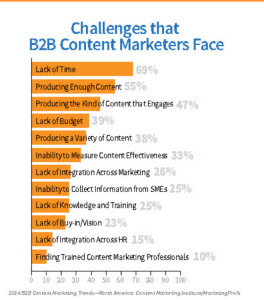Sales Content Challenges #3
This is the third article in this series about Sales Content Challenges, and for this article I would like to revisit my good friend Michael Cannon of the Silver Bullet Group (http://www.silverbulletgroup.com) and offer some outtakes from his Blog posting of 9/25/2013 “What is the cost of ineffective customer communications?” In this article Michael states: “Proof that most of your customer communications (marketing content and sales conversations) are probably ineffective can be seen in over a decade of research, which is summarized into the following Customer Communications Effectiveness Index:
- Less than 50% of your marketing content and sales conversations are relevant to your customers
- Less than 30% of your marketing content is relevant to your customer-facing teams
Just for a moment, consider these data points and the cost burden they place on your P&L. Even if your organization is 10% to 20% better than the average, the cost is still too high, and avoidable.
Use the following analysis points to help quantify your true cost:
Marketing and Sales Costs
- Cost to create and distribute ineffective marketing content. Marketing content includes collateral, demand-generation campaigns, sales tools, and sales support training provided by Marketing. Survey your customers and ask them what percentage of the marketing content was useful in helping them with their buying decision. Survey your sales team and ask them what percentage of the marketing content is useful in helping them create and win opportunities. Multiply the blended percentage that was not useful by the total dollars spent to create the content, including full-load salaries of employees, and external vendors such as agencies and media buys.
- Cost of content created by Sales (Direct/Indirect). Survey your sales team and ask them what percentage of their time they spend recreating/creating messaging/content because they do not have what they need. Multiply the percentage of time spent creating content by the sales team’s full-load salaries. What incremental revenue could be generated if 50% of this content creation time was instead spent with customers?”
Next, I would like to reference Stephen Diorio, of Profitable Channels (www.profitablechannels.com) from his excellent 2013 white paper “Effective Sales Content the Key to Sales Success”. Stephen writes: “As a direct consequence of these trends, spending on content is growing. Research by the Content Marketing Institute shows that, on average, B2B marketers spend one quarter of their marketing budgets on content marketing. And most plan to increase their spending on content in the next six months.
The bottom line is – the quality and effectiveness of your sales content directly impacts your sales effectiveness, customer experience, and cost to sell.
That said, sales content is an expensive asset that is generally mismanaged. Most B2B organizations create selling collateral, presentations, case studies, white papers and playbooks in a highly fragmented and undisciplined fashion. As a result, the sales content they create is often inconsistent, expensive, and not aligned with the sales process.
The business consequences of low quality and poorly organized content are unproductive selling efforts, a poor client experience, higher selling costs and, in most cases, outright waste.”
Again, I can’t thank both Michael and Stephen enough for their quality research and contributions to this area and I have to ask the reader, with this type of information and research being presented to them, why aren’t they more proactive in seeing this as a problem that needs to be fixed? Is it they:
- Don’t believe that they have the problem within their organization?
- Don’t think the problem deserves a high enough priority to solve?
- Think it’s a Marketing problem and one that only Marketing needs to deal with and solve?
- Haven’t really ever given it much thought before now?
I believe that most organizations simply don’t have visibility into what’s working and what isn’t and, therefore, don’t really know the answer to the above question because they don’t have a system in place, with feedback loops, to measure it. You cannot see what you do not measure. They know that something isn’t working and their sales people aren’t as effective and productive as they should be, but they just can’t seem to put their finger on what that something is. Hopefully, the research that both Michael Cannon and Stephen Diorio write about will help enlighten them to the point of doing something about it. At least that’s the way I see it. What say YOU?


